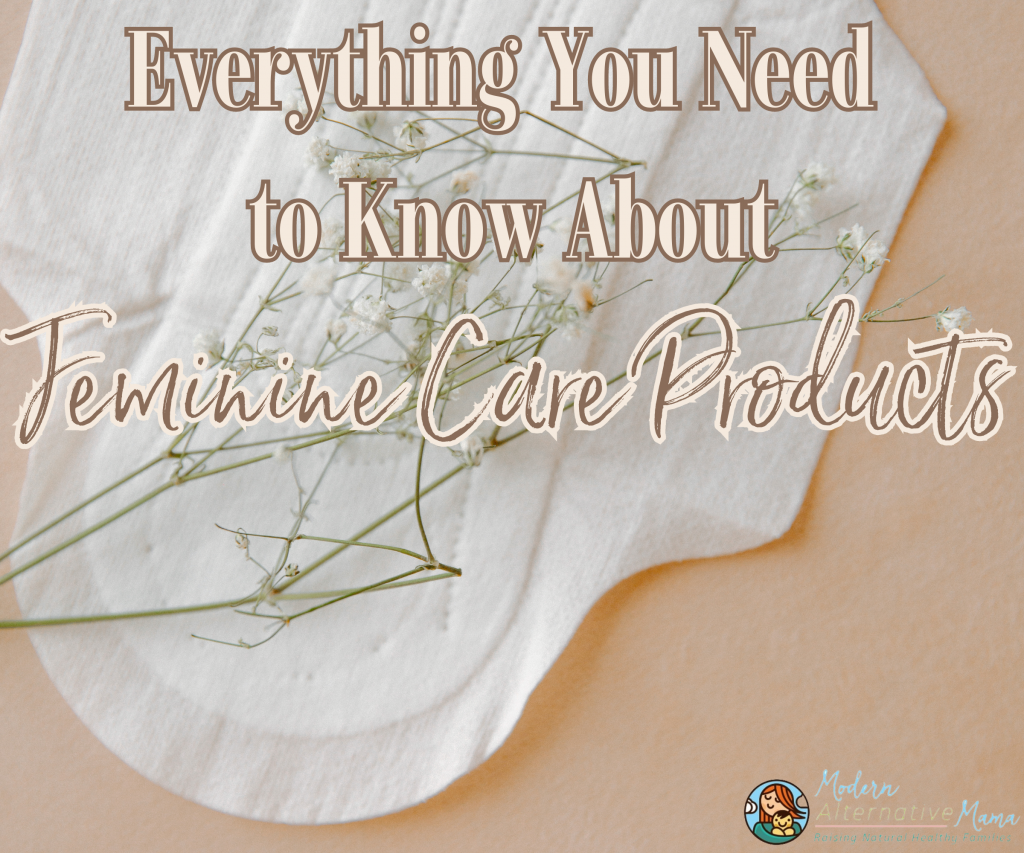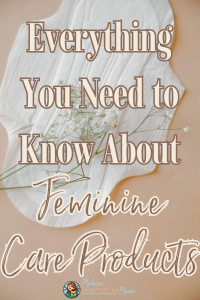Everywhere we go, there are toxins. We live in a toxin-filled world. Unfortunately, it’s hard to determine what products contain toxins. Sometimes, toxins linger in the least expected places – for instance, feminine care products such as pads and tampons.
Unfortunately, feminine care products like pads and tampons do not require an ingredient list, making it easy for toxins to find their way into them. This post will discuss common toxins found in each and safer, non-toxic alternatives you could try.
Personally, I don’t like tampons, even if they’re toxin-free, due to the possibility of toxic shock syndrome (TSS). Toxic shock syndrome is a sudden, potentially fatal condition. TSS affects menstruating women using tampons. TSS occurs when an overgrowth of bacteria (staphylococcus aureus, or staph) releases toxins suddenly. The body responds with an abrupt drop in blood pressure, depriving the organs of oxygen and potentially leading to death (1).
Common Ingredients/Risks of Sanitary Pads & Tampons
Before we dive into common ingredients and risks of sanitary pads and tampons, let’s discuss proper hygiene practices. Changing your pad or tampon every 3 to 4 hours is recommended to avoid the risk of bacterial infections (2). I highly recommend adopting these practices no matter what hygiene supplies you use. Additionally, some ingredients in mainstream options cause women to have intense menstrual cramps; if you struggle with that, I highly recommend Earthley’s Ease the Ache. You may also find that switching to a toxin-free alternative may minimize or even eliminate your menstrual cramps.
Polypropylene
Polypropylene is found in both pads and tampons and is a thermoplastic used to create a synthetic fabric to transfer moisture. Polypropylene is derived from hydrocarbon fuels and can negatively impact the environment and human health. Polypropylene contains toxic byproducts that can be hazardous when inhaled due to off-gassed volatile organic compounds or VOCs (3). Potential health effects of VOCs include damage to the liver, kidney, and central nervous system. Some VOCs are suspected or known to cause human cancer (4).
Calcium Chloride
Calcium chloride is often found in pads and is a salt comprising one part of calcium for every two parts of chlorine (5). Calcium chloride is the rock salt used for snow removal. Calcium chloride is known to cause skin irritation if your hands are moist when handling it (yet it’s in menstrual pads that are typically moist for long stretches of time. Additionally, calcium chloride can chemically attack concrete (6). Somehow calcium chloride is deemed safe for one of the most sensitive parts of a woman’s body.
Titanium Dioxide
Titanium dioxide is typically found in paints, plastics, pads, and tampons. Titanium dioxide is extracted using a Sulfate or chloride process (7). Studies show that the inhalation of titanium dioxide has been associated with increased lung tumors in rats (8). It’s important to note that sulfates are aggressive detergents or surfactants made of sulfur-containing mineral salts. Sulfates cause varying levels of skin and eye irritation, drying out the skin and leading to acne breakouts (9).
Petrolatum/Petroleum
Petrolatum or petroleum contains an increased level of xenoestrogens, which disturb the hormones and affect the body’s estrogen level (10). There is also the risk of polycyclic aromatic hydrocarbon (PAH) contamination in petroleum (11). Overall, this ingredient has been linked to estrogen dominance (12). Estrogen dominance is a common condition in which sufferers have a high ratio of estrogen, with little to no progesterone to balance its effects in the body (13). This ingredient is often found in pads.
Behenyl Alcohol
Behenyl alcohol is straight-chain alcohol widely used in cosmetics and personal care products, including sanitary pads (14). There is concern regarding contact dermatitis and potential respiratory irritation. This substance also harms the non-reproductive organ system, and contact with the skin may cause drowsiness or dizziness (15). Additionally, behenyl alcohol has several side effects, including but not limited to headaches, abdominal pain, nausea, dyspepsia, and hyperbilirubinemia (16).
Ditallowethyl Hydroxyethylmonium Methosulfate
Ditallowethyl hydroxyethylmonium methosulfate is a surfactant that enhances menstrual pads’ breathability and absorbency (17). This ingredient is rated a four by the Environmental Working Group (EWG) due to heavy concerns about allergies and Immunotoxicity and low, but still, concerns regarding cancer and developmental and reproductive toxicities (18).
Sodium Polyacrylate
Sodium polyacrylate is a chemical polymer used for absorbency. Sodium Polyacrylate is made up of acrylate compounds (19). Acrylates are typically found in artificial nail products. Acrylates have adverse skin, eye, and throat reactions (20). Acrylates have been associated with cancer, development issues, neurological and cellular damage, organ system, and reproductive toxicity (21).
Polyethylene Glycol (PEG)
PEG, or polyethylene glycol, is found in pads and tampons. This ingredient is a biocompatible, synthetic, hydrophilic polyether compound used as a binding and dispersing agent, as it can improve the separation of particles and prevent clumping (22). According to MADE SAFE,
“The primary concern with PEG compounds is that Ethylene Oxide is used in their production in a process called ethoxylation. This process can cause contamination with Ethylene Oxide, a chemical associated with multiple kinds of cancer. Additionally, ethoxylated ingredients can be contaminated with 1,4-Dioxane, a carcinogen (23).”
Diethylhexyl Sodium Sulfosuccinate
Diethylhexyl sodium sulfosuccinate is an anionic surfactant with 70% propylene glycol (24). Propylene glycol is a synthetic liquid used for its absorption abilities (25). Reported adverse effects from this ingredient include central nervous system (CNS) toxicity, hyperosmolarity, hemolysis, cardiac arrhythmia, seizures, agitation, and lactic acidosis. Additionally, prolonged exposure can lead to PEG toxicity (26). Yet women wear a pad for roughly 5 to 7 days per month.
That’s not even accounting for the fragrance, synthetic colors, and even chlorine often added to feminine care products.
Toxin-Free Feminine Care Alternatives
Of course, if you want the cleanest alternatives, it’s probably best to make your own. A great option is to make homemade mama pads, which are flannel on top for absorbency and softness, and they are PUL on the bottom, so they are waterproof, making them great for postpartum or menstruation. If DIYing isn’t your thing, here are some recommendations:
- Bamboo Reusable Sanitary Pads feature a leak-free outer shell of the cloth sanitary napkin with the comfort of the softer Bamboo layer against your skin. These cloth menstrual pads’ charcoal bamboo inner layers are soft with a stay-dry surface. The dark color is forgiving of stains. Not only great at soaking up liquid, but smells are also neutralized. Middle layers of microfiber make this reusable sanitary napkin super absorbent and a new trend in baby cloth diapers. Fold over and snap into place. Never feel embarrassed.
- Rael Protective Period Panties look and feel like regular underwear but are made with four layers of highly absorbent and waterproof fabric that absorb up to 3 tampons’ or one menstrual cup’s worth. It wicks away moisture in seconds to keep you feeling dry. These panties are made from 95% pure cotton and 5% spandex for a silky-soft and breathable fit.
- OrganiCup Menstrual Cup is made of 100% soft medical-grade silicone that doesn’t mess with your body. Organicup Period Cup can be used for any activity. It is washable and reusable, a great feminine hygiene product alternative to tampons and menstrual pads. Storage bag pouch made from organic cotton included. Safe and suitable for all women, teens, skin types, and menstrual conditions. Simple to insert and remove.




I read on the package of a menstral cup that they also can cause TSS. 🙁
That is true; menstrual cups can cause TSS, but from what I’ve read in scientific literature, it’s not very common. This article reports very few cases of TSS from menstrual cups and even found lower bacterial vaginosis cases in menstrual cup users. I hope that by sharing this article, you make an informed decision for your needs. 🙂
https://www.thelancet.com/journals/lanpub/article/PIIS2468-2667(19)30111-2/fulltext#seccestitle70